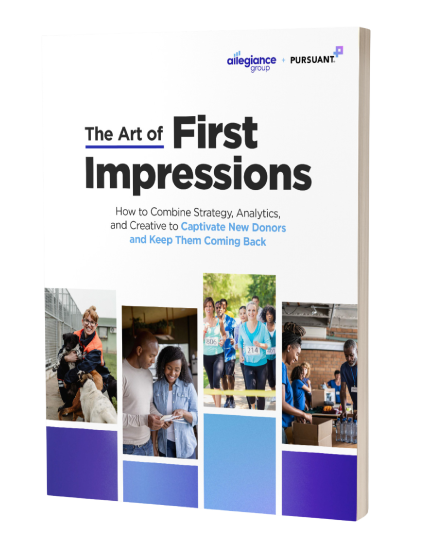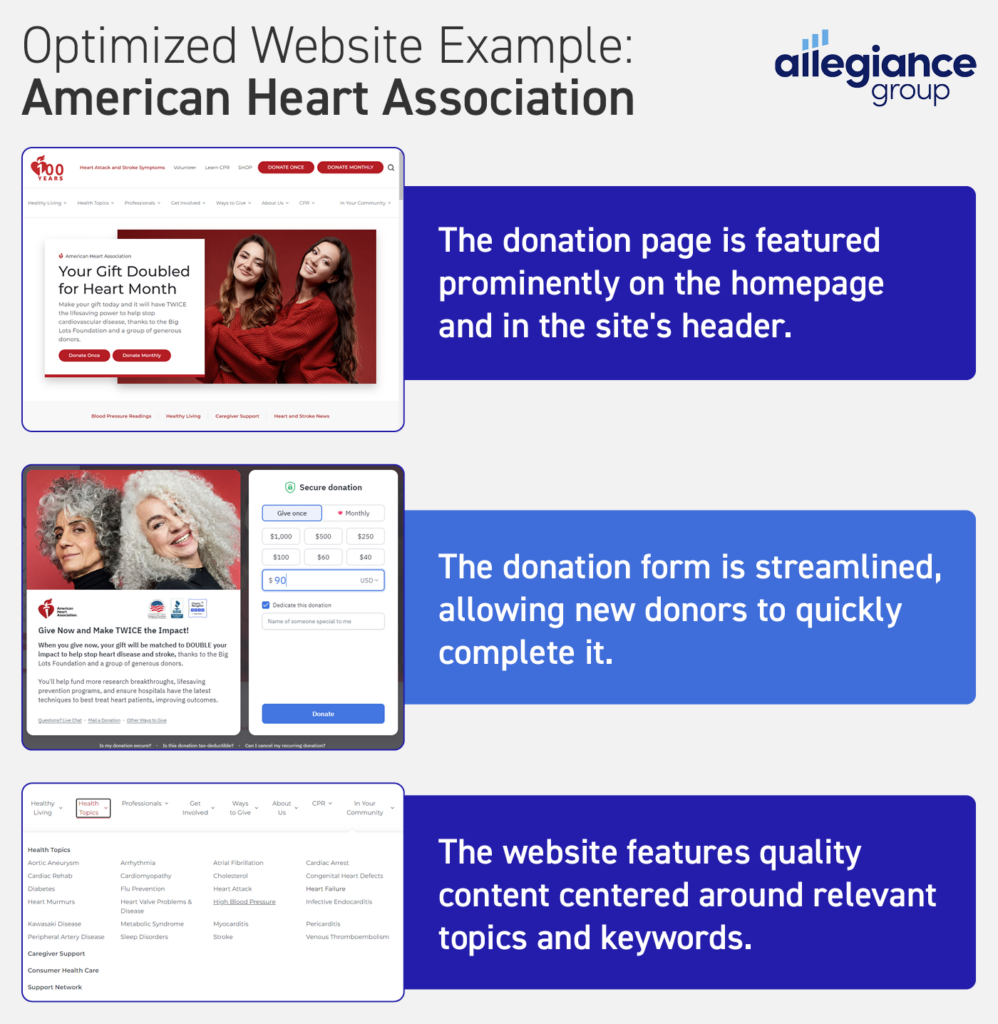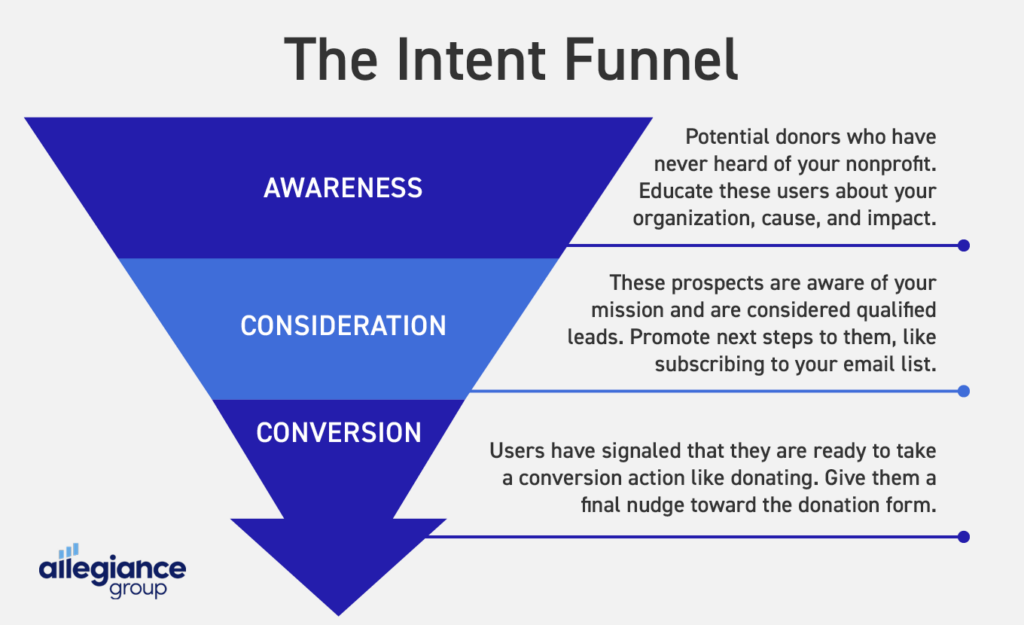Reach Full Funding Potential: 6 Donor Acquisition Strategies

Developing a digital donor acquisition strategy takes a similar approach to direct mail. It starts with a detailed analysis of your donor base, including average gift size, retention rates, and cost per acquired donor. Then, once you understand your audience members and which strategies resonate with them, you can build a strategy.
In this guide, we’ll explore the basics of donor acquisition and some nonprofit digital marketing best practices for finding new donors. Let’s get started!
Engage new donors from the start with compelling digital marketing.
What are the basics of donor acquisition?
What is donor acquisition?

Donor acquisition is the process of attracting new supporters and convincing them to donate to your cause through marketing efforts. Typically, this involves educating them about your cause or issue and highlighting your work.
To make a positive first impression and foster deep, long-term relationships with potential donors, center your purpose in your donor acquisition strategy. Supporters should clearly understand how you aid beneficiaries and further your mission. Additionally, you should tailor your efforts to your donors’ preferences, interests, and behaviors.
What is the difference between donor acquisition and retention?
Donor acquisition refers to how many new donors your nonprofit can attract within a given timeframe. Donor retention is how many donors continue to support your organization year over year. Nonprofits usually report retention as a percentage. For example, you might attract 150 new donors and retain 55% of your existing donors within a year.
While different, these concepts are related. Optimizing your donor acquisition efforts by personalizing them to each prospect and maintaining continued contact can improve retention down the line. Prioritizing donor stewardship efforts will help you retain more donors so your time, effort, and money spent acquiring donors isn’t wasted. After all, acquiring a new donor is much more expensive than retaining an existing one.
What are the steps to digital donor acquisition?
The steps in this process will look different from nonprofit to nonprofit. Plus, you’ll need to adjust it often to ensure you adapt to changing audiences and preferences. In other words, you’ll likely need to revisit each step of your donor acquisition process when your supporters inevitably change their preferences and affinities.
The basic roadmap for developing a digital donor acquisition plan looks like this:
- Identify your audience and get to know them. Create audience personas based on shared characteristics such as age, interests, and communication preferences.
- Evaluate past fundraising and acquisition campaigns. Which strategies were most effective at attracting first-time donors? How did these individuals hear about your nonprofit? Were there any patterns or trends in their behaviors (e.g., the timing of their donation)?
- Craft a conversion journey. Plot out the path that the average user will follow from hearing about your nonprofit for the first time to donating. You’ll want to be present and meet potential donors where they are in their journey. Be conscious of the fact that there are many paths they can take.
- Select communication channels and advertising platforms for the campaign. These should be channels and platforms that your audience regularly engages with. Be sure that your efforts take the full funnel into consideration. When the entire donor journey is addressed in your marketing plan, conversion rates for donor acquisition are much stronger.
- Launch your campaign. Prioritize educating donors first. Then, nudge them toward lead-capture opportunities, and, finally, compel them to donate.
Along the way, it’s key to track and analyze your campaign’s performance data. Evaluate your progress and course correct if some of your strategies aren’t resonating with your audience. Conversely, amplify the strategies or messages that lead to the most conversions.

Download your free copy of The Art of First Impressions.
Make an unforgettable first impression on potential donors with this 3-pronged approach.
How can nonprofits acquire new donors with digital marketing?
Digital marketing is an effective way to reach beyond your existing base of supporters. There are multiple communication channels your nonprofit can use to target and acquire new donors, from your website to paid avenues.
Here’s how to use six common digital marketing platforms to boost your donor acquisition rate:
Website
Your website is one of the most important tools in your donor acquisition toolkit. Potential donors use your organization’s website as a resource to learn who you are, what you do, and how to get involved.
Your nonprofit’s website should:
- Be easy to navigate through the use of intuitive menus and clear navigation titles.
- Capture new visitor information by employing lead capture forms (e.g., “Enter your email address to receive our monthly newsletter!”).
- Enable a seamless donation experience from every page by making it easy to find your donation form and make a donation.
- Follow accessibility guidelines such as ensuring sufficient contrast between text and background colors, adding alternative text to images, putting captions on videos, and making it possible to navigate the site with keyboard controls.
Once your website meets these basic requirements, you can use it in your acquisition efforts. Here are some additional steps to convert more potential donors who are visiting your websites:

- Link to your donation page. Add donate buttons to the top of your homepage and along your website’s header. This way, site visitors can access your donation form from any page in just one click—direct prospective donors to your donation page by adding inline donation forms or lightboxes to your top-performing content. Make sure the buttons are large and colorful so they stand out on the page.
- Optimize your donation form. By providing the easiest and best donation user experience, you can acquire more new donors and get more repeat gifts from existing donors. Streamline the form to ensure you ask only relevant questions, such as their name, email address, payment information, and whether they’d like to make the gift a recurring one. Flag any errors or missed fields before the donor submits the form to prevent mistakes.
- Prioritize SEO. Keywords facilitate the connection between your website and a prospective donor. For example, the American Heart Association has dozens of pages and blog posts that align with the keywords that constituents may be searching for, like “healthy lifestyle” and “heart murmurs.” Search engine optimization (SEO) allows you to harness the power of these keywords, boost your website’s ranking on search engines, and convert more visitors into donors.
Audit your content to evaluate how well your website meets user search intent. Use Google Analytics to track metrics like unique visitors, pageviews, backlinks, and more to identify how to create compelling online content.
Paid Advertising
Acquiring new donors through digital advertising involves channels like paid search, paid social, display, and video advertising.
Start with a specific digital advertising plan that accounts for assumptions, projected growth, budget, flight dates, your ideal donor profile, design, analytics, and reporting.
Some common considerations for growth include:
- Revenue vs. new donors: Decide how much of your paid media (advertising) efforts should focus on acquisition. While funding spent acquiring donors can result in fast growth, it also carries more risk because the acquisition cost is not offset until new donors give again.
- Audience priorities: If your acquisition goals are more specific, you may need to divide your acquisition budget among specific audience segments. For example, you may need to allocate different levels of ad spending to younger donors, more diverse donors, mid-level donors, and sustaining or monthly donors.
- Consider the full funnel: Ensure that your ad plan addresses each stage of the donor journey, keeping in mind the importance of specific messaging, targeting, and KPIs for each stage.

Awareness (Top of Funnel): At the top of the funnel, users are potential donors who have never heard of your organization. You’ll need to educate them by introducing your organization, the problem you are trying to solve, and the value your organization provides.
Consideration (Middle of Funnel): By the time a user reaches the middle of the intent funnel, they are aware of your organization’s mission and have been qualified as having the financial or other demographic markers of a potential donor.
Conversion (Bottom of Funnel): At the bottom of the funnel, users have signaled that they are ready to take a conversion action like donating. They include recent donors and users who have demonstrated high engagement on your website or initiated another intent signal (e.g., subscribing to your newsletter).
Once you’ve established the project’s context and goals, shift your focus to how you’ll execute the campaign, including decisions about ad copy, design, and where to place ads.
Social Media
Developing a following on popular social media channels will drive more traffic to your website, motivating more potential donors to interact with lead capture forms or contribute to your cause. After all, 32% of donors are most inspired to give via social media. If you can inspire prospective supporters to join your email list, you can send them your welcome email series to nurture a relationship that eventually leads to a donation.
Here are a few tips for using Facebook and Instagram to acquire donors:
Facebook & Instagram (Meta)
These platforms play a role at every funnel level, from introducing users to your brand for the first time to asking your sustaining donors to upgrade. Both platforms have unique strengths and capabilities and integrate seamlessly.
The targeting power of Meta’s data, combined with the ability to upload your own first-party data, makes it easy to reach new donors. The familiarity of their environments makes them a comfortable place for users from all segments to convert. These platforms allow brands to find new users based on detailed demographic data, making it a great option for lead generation and direct-to-donor prospecting. Many organizations use social to augment email, support direct action efforts, improve user awareness of brand activities, and promote donor engagement.
While it’s important to have a strong social following, it’s equally important to recognize the importance of a paid and organic presence in working together. Your social followers want to hear updates on the organization’s progress and be informed of your work to advance the mission. Followers don’t want to see frequent donation asks from your page. Reserve the majority of donation asks for paid efforts, where you can exert more control over the targeting and can also ensure that your ask is seen.
Keep in mind that these platforms are good for much more than just donor acquisition. Spread the word about your monthly giving program, recruit volunteers, re-engage lapsed donors, and more.
Paid Search Engine Marketing (SEM)
Paid SEM refers to paid media efforts on search engines, usually Google and Bing. Advertisers bid on user search terms and keywords to serve ads to individuals who may exhibit interest in a similar organization or related topics.
Paid search has become a channel that reliably generates new-to-file donors, even when brands bid on their name alone (branded search). Paid search is consistently one of the top revenue drivers across paid campaigns for clients across all nonprofit categories because of the user mindset at the time they search. For example, our client, the Georgia Mountain Food Bank, saw great success from a recent paid search campaign. The organization earned a 200% return on ad spend from the campaign, translating to more than $36,500 in donations.
Developing a digital donor acquisition strategy takes a similar approach to direct mail. It starts with a detailed analysis of your donor base, including average gift size, retention rates, and cost per acquired donor. Then, once you understand your audience members and which strategies resonate with them, you can build a strategy.
In this guide, we’ll explore the basics of donor acquisition and some nonprofit digital marketing best practices for finding new donors. Let’s get started!
Ready to see the impact of effective, compelling digital marketing at your nonprofit?
Programmatic Advertising
Programmatic ads are powered by a diverse and powerful ecosystem of advertising technology providers who offer unique and more surgical, validated targeting data than is available through other platforms. This provides an opportunity to target users based on criteria such as demographics, psychographics, donor behavior, content consumption, and more.
Programmatic ads are delivered across the web within brand-safe content and offer an amazing variety of creative variations to help bring your organization’s mission to life. Possibilities include display, interactive rich media, native, video (streaming, CTV/OTT, preroll), and more. Creative variations are a powerful weapon to move potential donors through the funnel to conversion.
Fixed CPA Platforms
Fixed CPA platforms, such as Fluent and Care2, are great for achieving top-of-funnel lead generation on a large scale. They allow for performance-based pricing in lead generation and help you reach new supporters who are involved in social good communities. Simply put, they can grow your list of donors by sending messages about your cause to untapped audiences.
Nonprofits can essentially purchase leads at a set cost per action (CPA). Although these campaigns can involve longer lead times to see fundraising results, programmatic buys paired with robust messaging campaigns can positively impact list growth.
Wrapping Up
Digital channels play a crucial role in your donor acquisition strategy. Technology has dramatically expanded how organizations attract and retain donors, and the potential to go “viral” inspires organizations to strive for ambitious goals. As you leverage our digital donor acquisition strategies, keep these fundamentals in mind:
- Show up where your likely donors already spend much of their time.
- Share consistent and compelling messages.
- Keep the conversation going with prospects through dedicated follow-up.
Remember that online donor acquisition campaigns don’t exist in a vacuum. There is enormous potential to conduct cross-channel campaigns designed to work with existing efforts. Here are some additional resources you can leverage to build a well-rounded marketing strategy:
- Direct Mail Donor Acquisition Strategies. Complement your digital donor acquisition efforts with a compelling direct mail campaign. Learn more in this guide.
- How to Choose the Right CMS for Your Nonprofit. Donor data is the foundation of any successful acquisition strategy. Explore these tips for choosing the best constituent relationship management (CRM) platform for your needs.
- Nonprofit Elevator Pitch: Tips for Crafting Your Appeal. Want to make your acquisition tactics and fundraising appeals more eye-catching and effective? Check out these tips to improve your messaging.